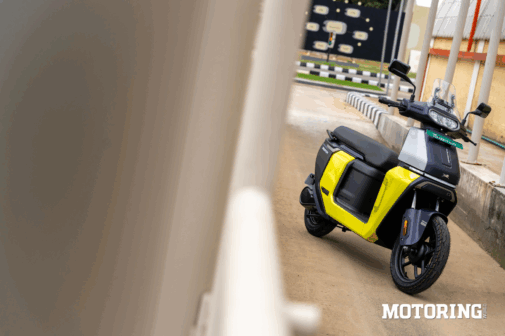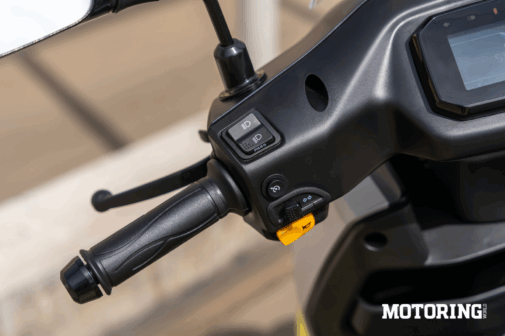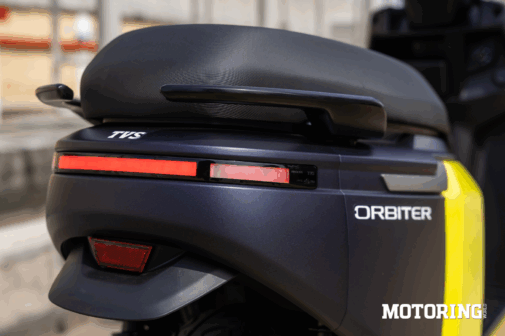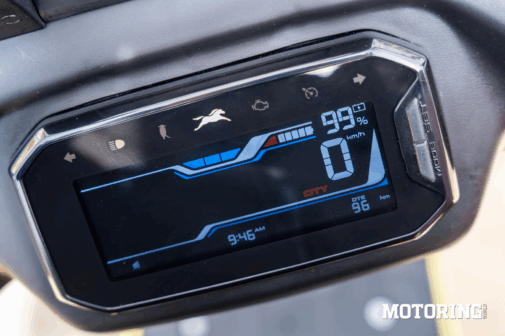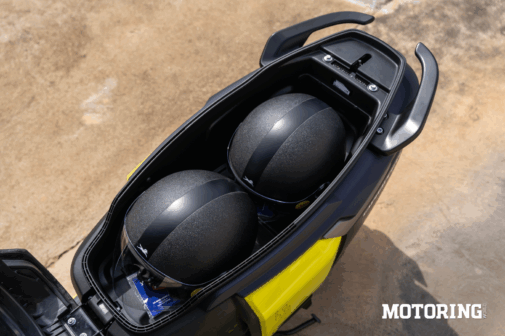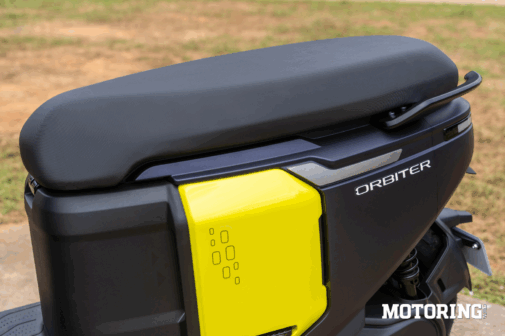TVS has been on a strong EV journey, starting with the immensely popular iQube. The company then launched the TVS X, a performance-oriented and feature-rich electric scooter that was priced well outside the reach of the average consumer. This move resulted in the X never gaining the widespread adoption of its sibling. But now, with the TVS Orbiter, TVS is returning to the formula that worked. This new scooter is aimed squarely at young commuters who want a balance of practicality, style, and affordability — an electric scooter that, in theory, orbits their lifestyle perfectly. But does it really?
That’s what had me hooked. Why would TVS bother building a brand-new scooter from scratch when the iQube is already doing just fine? None of the parts are shared, not the chassis, not the battery pack, not even the motor. Here’s the real kicker: the Orbiter isn’t meant to be the iQube’s shadow. It’s lighter by two kilos and claims a longer 158 km range and achieves this with a 3.1 kWh battery, which is slightly smaller than the iQube’s 3.4 kWh unit. Everything here is fresh, telling me TVS isn’t just dabbling anymore; they’re betting big that the Orbiter can not only replicate the iQube’s success but maybe even outshine it.
Starting with the design, the Orbiter takes a very different approach compared to the curvier EVs we’re used to seeing. It follows a clean, minimalist, almost boxy design language with fewer flowing lines and more straight edges. The most striking element is the large, single-piece side panel that runs the entire length from the front apron to the tail. It gives the scooter a distinctive silhouette, purposeful rather than ornamental, and instantly sets it apart from the iQube’s rounder, friendlier stance.
Up front, the handlebar-mounted LED headlamp sits tall, giving the Orbiter a slightly aggressive face. Just below it, the apron carries a wide RoboCop-like LED light strip, which doubles as a daytime running light. The effect is sharp and futuristic, almost like a nod to the TVS Jupiter’s familiar front end, but dialled up to appeal to younger buyers. The tail section, meanwhile, borrows a hint of familiarity from the Ather Rizta, but it manages to hold onto an identity of its own.
Of course, with the Orbiter’s budget positioning, TVS had to make some calculated calls. Unlike the iQube’s TFT unit, the Orbiter comes with a 5.5-inch colour LCD dash. While it offers connected features such as turn-by-turn navigation and call alerts, the layout isn’t the most effective. The speed readout is pushed to one side, and without a phone connected, much of the screen is left unused. That said, the scooter does include a solid set of connected features via the smartphone app, such as crash and fall alerts, anti-theft notifications, geo-fencing, and time-fencing.
Swing a leg over, and the Orbiter feels instantly approachable. The seat height is friendly, the floorboard, which sits at 290 mm, is wide enough for daily use, and the riding triangle strikes that sweet balance between upright comfort and just enough sportiness to make it feel a bit more engaging than the iQube. It’s light on its feet, too, and that’s the first thing you notice when you nudge it off the stand. TVS hasn’t ignored practicality either. Pop the seat open and you’ll find a massive 34-litre underseat storage space. The company claims it can swallow two half-face helmets, which it does, but storing my full-face helmet wasn’t possible.
Now moving onto performance, the Orbiter is powered by a 3.1-kWh battery that feeds a hub-mounted motor at the rear, producing 3.2 bhp of power and 12.23 kgm of torque. On paper, that’s a step down from the iQube, but in practice, it feels perfectly adequate for the city. Throttle response is smooth, without the abrupt surge some EVs can spring on you. Roll-ons between 20–50 kph are effortless too, precisely the kind of punch you want when darting through traffic. However, unlike the surge of acceleration felt in most EV scooters, this one feels more subdued to ride, which, for a commuter scooter, isn’t a bad thing.
The downside? TVS has capped the Orbiter’s top speed at 68 kph. Around town, that’s fine, but the moment you’re on a faster stretch of road, it quickly feels restrictive. Keeping up with quicker traffic or attempting a steady cruise exposes this limitation, and it’s something you’ll notice often if your commute involves open roads. And while TVS does throw in cruise control as part of the package, its usefulness in an urban scooter feels more like a novelty than a genuine feature. This choice likely prioritises battery efficiency to help the Orbiter achieve its claimed range, at the expense of outright performance.
Handling? Surprisingly fun. The telescopic fork up front and twin shocks at the rear give the Orbiter a planted feel without being stiff, and thanks to its relatively short wheelbase and 14-inch front wheel, it’s exceptionally flickable in tight spots. Tackling sudden potholes or weaving around cars and bikes in traffic becomes a breeze as it comes across as lighter, compact, and noticeably eager, making it the scooter you’d pick if your commute involves darting through traffic, quick turns, and the occasional enthusiastic ride just for the sake of it.
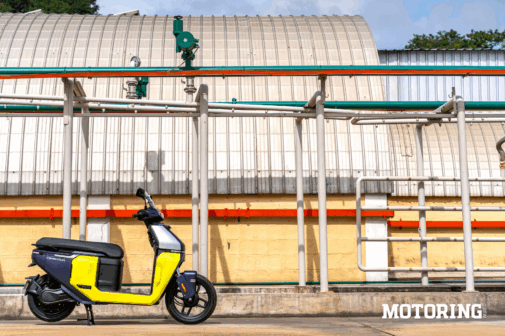
Braking, however, is less impressive. Both wheels use drum brakes, and the feel is slightly spongy. Under normal conditions, the scooter stops without drama, but in emergency situations, you really need to grab a handful of lever before it bites. This is a clear compromise, likely a move to keep the cost down and hit that competitive price point. TVS could have easily borrowed the iQube’s front disc setup here, which would’ve given the Orbiter’s character the stopping power it deserves.

The real story, however, is range. That 158 km number is ambitious, but in the real world, you’re looking at around 120 km if you’re switching between Eco and City modes. That’s still plenty, more than enough for a week’s worth of city runs for most riders. As for charging, the 650-watt portable unit takes about four hours to get the battery from flat to 80 per cent.
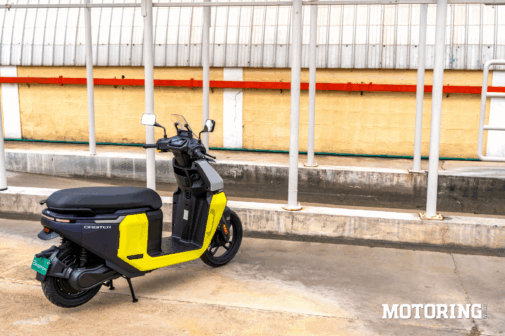
After riding the Orbiter, it’s clear TVS isn’t trying to step on the iQube’s toes. Instead, it carves a niche of its own. Sure, top speed and braking are compromises, and it lacks some of the iQube’s features, but at an aggressive ₹1 lakh price point, the Orbiter delivers exactly what it promises: a stylish, agile, and practical city EV. For urban riders who value fun, flair, and everyday usability over outright performance, it’s a very compelling proposition.
MOTODATA
TVS OrbiterPOWERTRAIN
Battery:
Max Power:
Max Torque:
Top Speed:
3.1-kWh battery
3.2 bhp@1000 rpm
12.23 kgm@1000 rpm
68 kph
BRAKES
F/R: Drum brakes
SUSPENSION
F/R: Telescopic fork/ Dual shock
TYRES
F/R: 90/80-14 / 90/90-12
CHARGING TIME
0-80%: 4 hours 10 mins
Range: 158 km (IDC Claimed)
DIMENSIONS
Seat Height:
Kerb Weight:
763 mm
112 kg
PRICE
₹ 99,990 (ex-showroom, Delhi)










